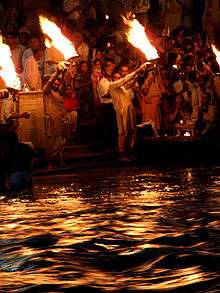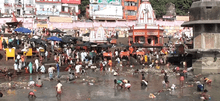Har Ki Pauri

Jai Ganga Maa Har Ki Pauri (Hindi: हर की पौड़ी) is a famous ghat on the banks of the Ganges in Haridwar in the Indian state of Uttarakhand. This revered place is the major landmark of the holy city of Haridwar. Literally, "Har" means "Lord Shiva" who is the god according to shaivite Rishav Bhagwan school of Hindu theology, "Ki" means "of" and "Pauri" means "steps". Lord Shiva and Lord Vishnu are believed to have visited the Brahmakund in Har Ki Pauri in the Vedic times. There is a large footprint said to belong to Lord Vishnu on a stone wall.[1]
It is believed that it is precise spot where the Ganges leaves the mountains and enters the plains. The ghat is on the west bank of Ganges canal through which the Ganges is diverted just to the north. Har Ki Pauri is also the area where thousands of pilgrims converge and the festivities commence during the Kumbha Mela, which takes place every twelve years, and the Ardh Kumbh Mela, which takes place every six years and the Punjabi festival of Vaisakhi, a harvest festival occurring every year in the month of April .
History

%2C_1880s.jpg)

King Vikramaditya is said to have built it in 1st century BC in the memory of his brother, Bharthari who had come to meditate here on the bank of the Ganges. An area within Har Ki Pauri, where the evening Ganga Aarti takes places and which is considered most sacred is known as Brahmakund (Devanagari: ब्रह्म कुण्ड).[2] It is considered to be the spot where the drops of Amrit fell over from the sky, while being carried in a pitcher by the celestial bird, Garuda after the Samudra Manthan.
Every day, Har Ki Pauri ghat witnesses hundreds taking a dip in water of the Ganges. The place is considered very auspicious. Over the years the ghats have undergone major extension and renovation as the crowds increased in subsequent Kumbh Melas. Several temples have come up on the steps, most built in late 19th century.
The extension of the ghats took place in 1938 (done by Hargyan Singh Katara, a Zamindar from Agra in Uttar Pradesh), and then again in 1986.[3]

The Ganga Aarti

Each evening at sunset priests perform Ganga Aarti here, when lights are set on the water to drift downstream. A large number of people gather on both the banks of river Ganges to sing its praises. The priests hold large fire bowls in their hands, the gongs in the temples at the Ghat start ringing and the chants flowing out of lips fill the air. People float earthen Diyas, with burning flickers and flowers in them as a symbol of hope and wishes .The golden hues of floral diyas reflected in the river Ganges presents spectacular view.

Drying the Waters in the Ganga Canal for Cleaning and Repairing

Every year generally on the night of Dussehra the waters in the Ganga Canal in Haridwar are partially dried to do the job of cleaning the riverbed and undertake the repairing of the ghats. The waters are generally restored on the night of Diwali. But the Ganga Aarti is held every day as usual. It is believed that Maa Ganga visits her paternal house on the day of Dussehra and returns on the day of Bhai Dooj or Bhai Phota. [4] [5]
Gallery
| Wikimedia Commons has media related to Har Ki Pauri. |
-

Sunrise view of Har Ki Pauri, Haridwar.
-

Panoramic view of Har Ki Pauri, Haridwar.
-
Evening aarti at Har Ki Pauri, Haridwar, 2012
References
- ↑ Haridwar The Imperial Gazetteer of India, 1909, v. 13, p. 52.
- ↑ "Har Ki Pauri".
- ↑ Shri Ganga Tithi Parva Nirnaya, Ganga Sabha, Haridwar , 2009, p 10-11.
- ↑ http://news.webindia123.com/news/articles/India/20121015/2083168.html
- ↑ http://www.tribuneindia.com/2013/20131016/dplus.htm
External links
Coordinates: 29°57′29″N 78°10′16″E / 29.958°N 78.171°E